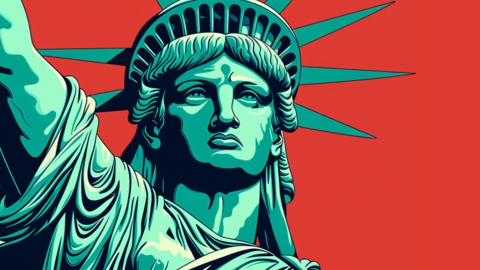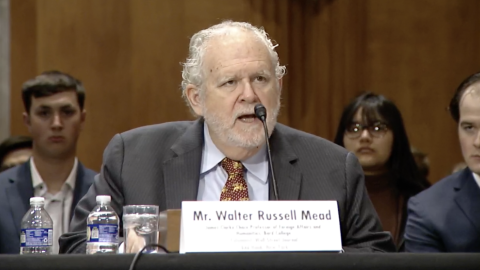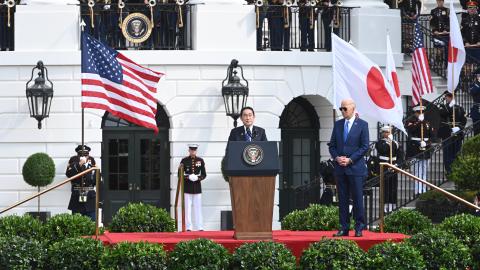Chef José Andrés is the "Chief Culinary Advisor" for "What's Cooking, Uncle Sam? The Government's Effect on the American Diet," an exhibition now at the National Archives in Washington. In his introduction to the show's catalogue, the chef writes that the exhibition inspired him to partner with the National Archives Foundation to launch a new restaurant, America Eats. Although Andrés is better known for paella than pot roast, his new venture located, we are helpfully told, "just steps away" from the Archives building features a neoNew Deal menu.
"What's Cooking, Uncle Sam?" documents the influence of Washington over our diet through an engaging selection of documents, photographs, and posters from the Archives' vast collection. Although the exhibition is admirably concise, the sequencing of the displays could be less complicated and clearer; at times the viewer struggles to understand which direction to take.
Much of the material revolves around the Department of Agriculture and other federal agencies with legislative authority over food production, regulation, and nutrition. From the mid19th century, these bureaucracies have played an enormous role in what winds up on our dinner tables.
The exhibition begins with the introduction of new plant species from around the word by Department of Agriculture scientists, such as Fred Meyer and other plant explorers who helped diversify American agriculture. They had been preceded by other amateur botanists, including Thomas Jefferson (who risked the death penalty by smuggling contraband rice from Italy).
Given his desire for an agrarian America, Jefferson might have approved of the federal seed-distribution program, another of the exhibition's topics. Supervised, oddly enough, by the Patent Office, it sent a billion packets of seeds to farmers before Congress quashed the program in 1924, under pressure from the seed trade association, which objected to the government giveaway.
A long letter of 1906 from Sinclair Lewis to President Roosevelt mentioning the "condemned meat industry" serves as a springboard for coverage of the Pure Food and Drug Acts of the same year. Roosevelt was not a fan of Lewis: "I have an utter contempt for him. He is hysterical, unbalanced, and untruthful. Three-fourths of the things he said were absolute falsehoods. For some of the remainder there was only a basis of truth." Roosevelt did, however, promise Lewis that he would investigate the "specific evils you point out," and he did sign the Pure Food and Drug and Meat Inspection acts that cleaned up America's food. (There's an amusing text in the exhibition describing how adulterated ketchup exploded, and why candy was such a deadly treat.)
The government's role in food includes policing as well as policy. An interesting section of the exhibition is titled "Crimes Against Butter." Margarine, a butter "substitute," was vigorously combated by the dairy industry, which organized an early mass mailing to Congress opposing its sale; one of the printed mailings is on display in the exhibition. The result was the Margarine Act of 1886, which aimed to license and tax margarine out of business. Violations of the act were severely punished: Mug shots of offenders, two of whom ended up in Leavenworth, illustrate the point.
Posters display the ever-changing government-recommended Food Groups: One from around 1945 lists butter as its own food group. These Food Groups and the Federal National School Lunch Program, started in the 1940s, still the shape the diet of millions of students. We are told that the Program "is one of the most popular social welfare programs in our nation's history." There is no mention, however, of the food-stamp program, which the Agriculture Secretary Tom Vilsack recently declared an "economic stimulus."
A series of striking graphics illustrate the government's role in feeding the armed forces throughout our nation's history. The earliest, a broadside of 1776, lists the daily rations for soldiers, which included a pound of beef, a pound of flour, one pint of Indian meal, and one quart of spruce beer (concocted from spruce tips and molasses) or "cyder" (of the hard variety, one presumes).
Concluding the exhibition is a section on the favorite foods of the presidents: Ike's vegetable soup, LBJ's Pedernales River chili, Reagan's jelly beans, and so forth. Although diverting, this section appears an afterthought and adds nothing to the main theme of the exhibition, except perhaps some star power.
Although skillfully done, "What's Cooking, Uncle Sam?" is marred by its cheerleading for the massive role of Washington in the lives of Americans. There is never a scintilla of doubt that federal regulation has been, and still is, a good thing; never a hesitation about how the thicket of regulation and rules affects the individual liberties of millions of Americans, for good or bad. For example, the massive failure of the federal prohibition of alcohol is ignored, as are controversial farm subsidies and agricultural tariffs, among the many other less than successful, or controversial, programs.
The exhibition coincides nicely with the nutritional directives now emanating from the East Wing of the White House. The catalogue, but not the exhibition, features a full-page photo of Michelle Obama, our nation's dietitian-in-chief and anti-obesity crusader, in her White House garden with a group of toque-wearing chefs looking like they're eager to harvest some of the First Lady's healthy foods (perhaps arugula). This bit of gratuitous puffery by the National Archives, an independent federal agency, is unseemly, but not out of line with its exhibition's sunny view of big government.













